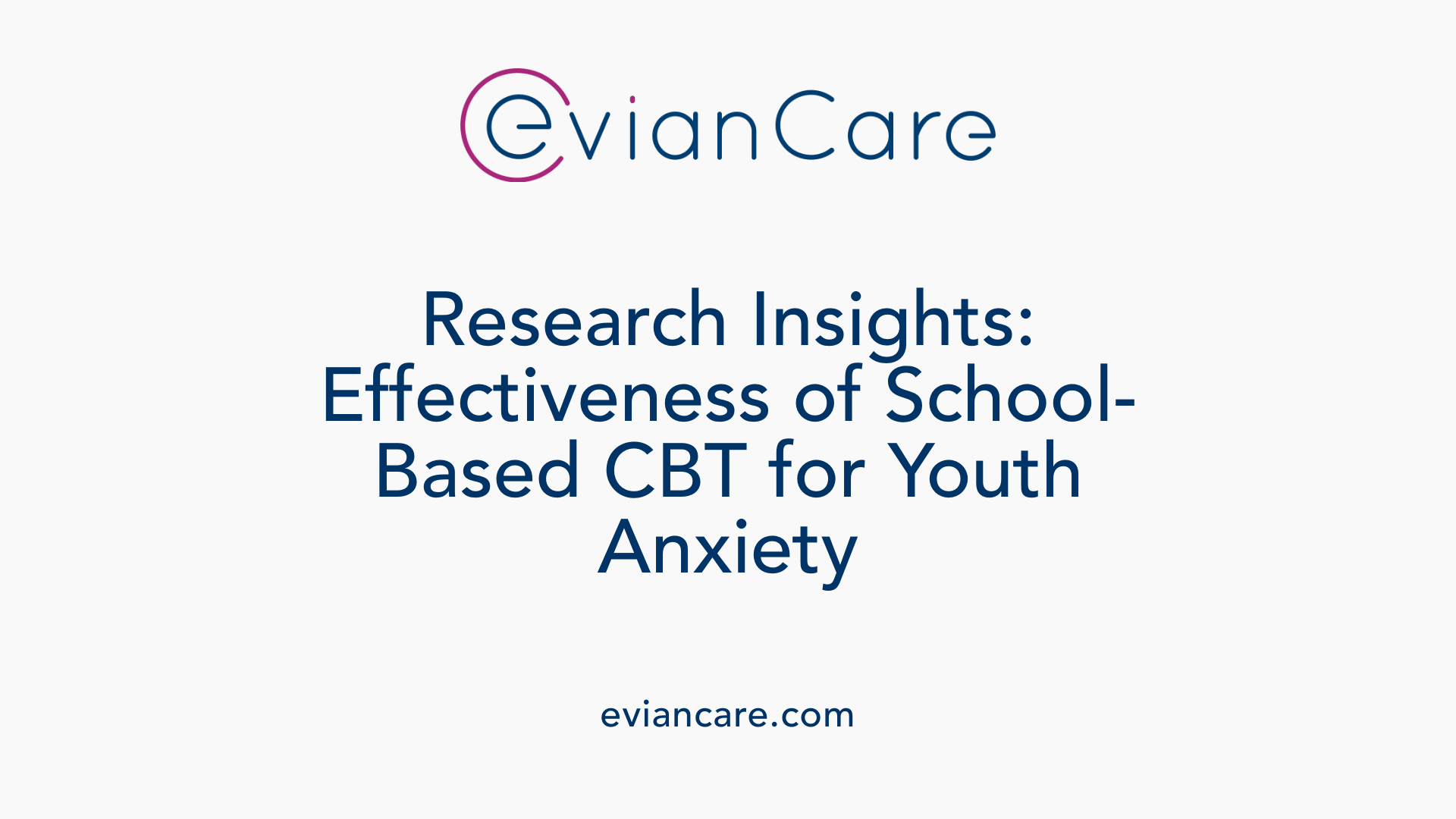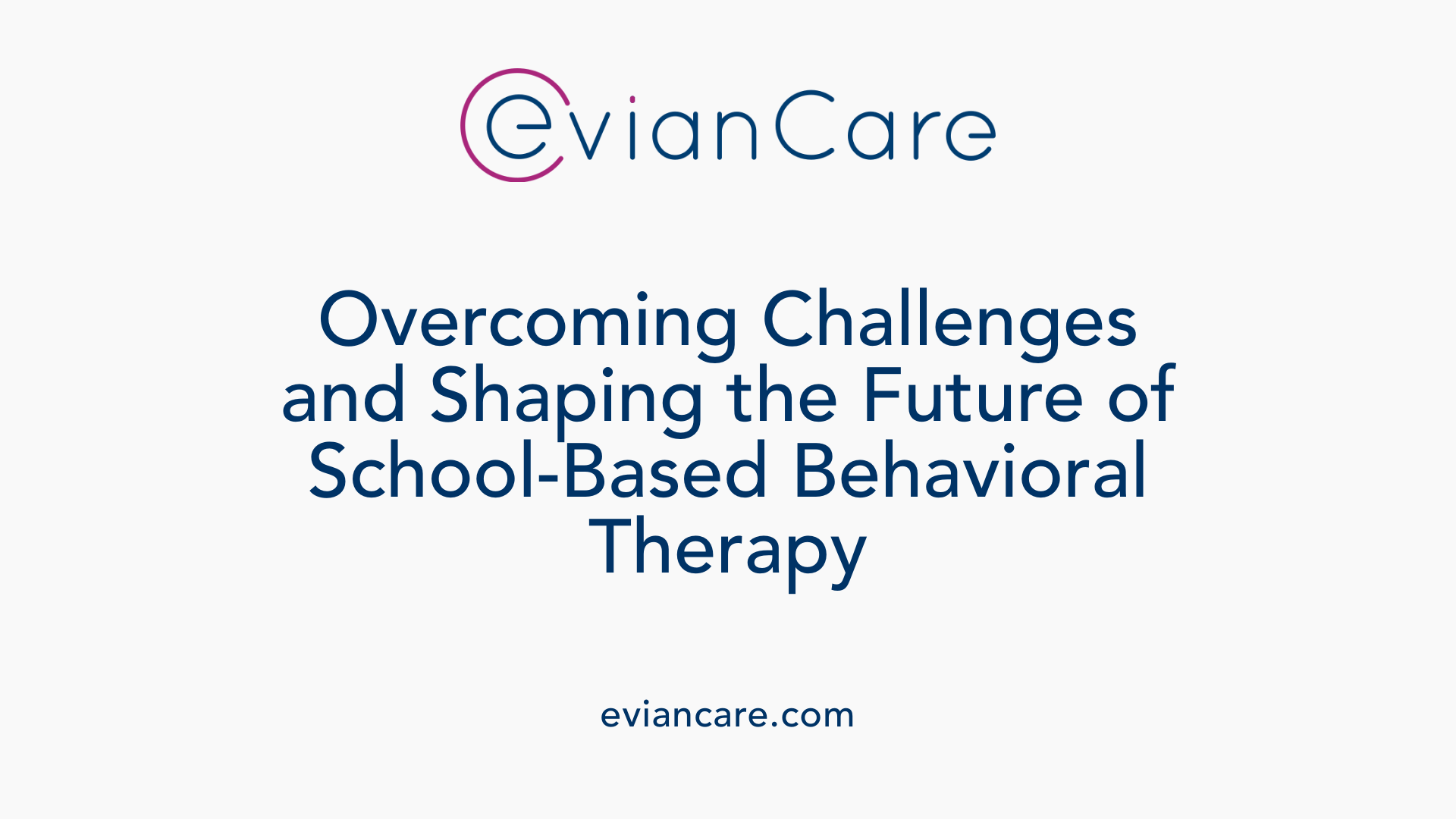
Enhancing Student Well-being Through Behavioral Approaches
Addressing anxiety in school-aged children is a growing priority for educators and mental health professionals. Behavioral therapy, especially cognitive-behavioral therapy (CBT), has emerged as a highly effective, evidence-based method for managing anxiety within educational environments. This article explores how behavioral therapy techniques are tailored for schools, the resources available to support implementation, and the scientific evidence underpinning their success.
Understanding Behavioral Therapy and CBT in Schools
What is behavioral therapy, especially CBT, and how is it used to manage anxiety in educational settings?
Behavioral therapy, with a focus on cognitive-behavioral therapy (CBT), is a proven, evidence-based approach aimed at helping children and adolescents understand and change the thoughts and behaviors that contribute to anxiety. In school environments, CBT is adapted into tailored programs that are delivered by trained school staff such as nurses, counselors, or external mental health professionals.
School-based CBT programs typically focus on core skills like recognizing anxious thoughts, restructuring negative thinking, exposure to feared situations, and developing emotional regulation strategies. For example, interventions like the "Cool Kids" program and cognitive-behavioral in vivo therapy (CBITs) have demonstrated significant success in reducing anxiety symptoms among students.
These programs can be offered through various formats, including individual therapy, group sessions, and family involvement techniques to support more comprehensive care. The delivery of CBT in schools makes mental health support more accessible, helping students manage anxiety effectively while maintaining their academic and social functioning.
Overall, school-based CBT is a promising approach that promotes resilience, improves mental health, and fosters positive developmental outcomes for young learners struggling with anxiety.
Significance of School-based CBT for Youth Anxiety

What does research say about the effectiveness of behavioral therapy for student anxiety?
Research indicates that school-based cognitive-behavioral therapy (CBT) is generally effective in reducing anxiety symptoms among students, including social anxiety. Multiple studies and meta-analyses have shown small to moderate effects, highlighting that targeted interventions can significantly improve emotional well-being.
Programs such as FRIENDS, SSL (Facing Your Fears), and SASS have consistently demonstrated better outcomes for students compared to control groups. These programs focus on core CBT elements, such as psychoeducation, affect regulation, cognitive restructuring, and exposure to anxiety-provoking situations, making them suitable for school settings.
Importantly, many studies report that these benefits are maintained over time, with follow-up assessments at 6 to 12 months showing lasting reductions in anxiety symptoms. This indicates that school-based CBT not only provides immediate relief but also supports long-term mental health improvements.
However, research also highlights some limitations. Many studies face challenges like high dropout rates, variations in program fidelity, and inconsistent implementation across different schools. These factors could influence the overall effectiveness and point to the need for more rigorous, standardized research designs.
Implementing CBT in schools also helps develop students' resilience and emotion regulation skills, which can translate to better academic engagement and social functioning. Overall, the evidence supports the integration of CBT into school mental health programs as a vital tool for managing youth anxiety, but ongoing efforts to improve delivery and evaluation are essential.
Implementation and Delivery of CBT in Schools

How can behavioral therapy be practically implemented and applied in school settings?
Behavioral therapy, particularly cognitive-behavioral therapy (CBT), can be effectively integrated into school environments through several practical strategies. First, training teachers, school counselors, nurses, and mental health professionals in evidence-based CBT techniques is essential. These techniques include cognitive restructuring, behavioral activation, exposure, and problem-solving skills, which are adapted for use by non-specialist staff.
One approach involves embedding CBT principles into class routines, such as using short, focused activities for emotional regulation and coping skills during the school day. Group interventions are especially efficient; trained school staff or external professionals can conduct sessions focused on anxiety, depression, or behavioral issues. These group programs often include role-playing, modeling, and reinforcement strategies to foster engagement and facilitate behavior change.
Technology plays an increasingly vital role. Digital tools like smartphone apps, online therapy modules, and virtual reality environments can make interventions more accessible and engaging for students. These tools help sustain motivation, provide immediate feedback, and support skill practice outside of sessions.
To ensure success, ongoing assessment and progress monitoring are vital. Regular checks through observational data, rating scales, and skill tests help tailor interventions to each student's needs. When combined with a supportive school climate and policies that prioritize mental health, these practical implementations can lead to meaningful reductions in anxiety and other emotional difficulties among students.
Core Components and Adaptations of School-based CBT

What are effective interventions and techniques of behavioral therapy for anxiety in educational environments?
In school settings, evidence-based behavioral therapies, especially Cognitive Behavioral Therapy (CBT), are among the most effective approaches to manage anxiety among youth. These interventions focus on helping children identify and challenge negative thought patterns that contribute to anxious feelings.
A fundamental element is psychoeducation, which teaches students about anxiety, how it affects their thoughts and behaviors, and normalizes their experiences. This foundational understanding reduces fear of symptoms and encourages active participation in therapy.
Cognitive restructuring plays a pivotal role, helping students identify maladaptive thoughts and replace them with more realistic and calming alternatives. For example, a child anxious about public speaking might learn to challenge the thought, “I will embarrass myself,” replacing it with, “I have prepared well, and I can handle this.”
Exposure therapy is also central, involving systematic and gradual exposure to feared situations. Children might start with imagining a scenario and progress to speaking in front of small groups, ultimately facing more challenging fears. This hierarchy of fears helps build confidence and reduce avoidance behaviors.
To support emotional regulation, interventions incorporate relaxation techniques such as deep breathing, progressive muscle relaxation, and mindfulness exercises. These skills help children manage physiological symptoms of anxiety during stressful situations.
Adapting these techniques for children with Autism Spectrum Disorder (ASD) involves visual aids, social stories, and structured routines. Visual aids like charts and illustrations help clarify abstract concepts and guide children through exercises. Social stories accommodate their learning preferences, providing clear scripts that depict social interactions and expected responses.
Enhancing engagement, visual tools like emotion thermometers or social stories make CBT more accessible and relatable. These adaptations ensure that children with ASD can participate fully and benefit from interventions, making therapy more effective.
In conclusion, school-based CBT combines core components like psychoeducation, cognitive restructuring, and exposure with practical adaptations such as visual supports for children with ASD. This integrated approach provides students with the skills necessary to cope with anxiety and improve their overall wellbeing in the school environment.
CBT for Autism Spectrum Disorder and Special Needs Students
How does behavioral therapy address anxiety disorders, including those related to autism spectrum disorders, in school-aged children?
Behavioral therapy, primarily cognitive-behavioral therapy (CBT), is an effective approach to treat anxiety disorders among school-aged children. It focuses on structured, evidence-based techniques like exposure to feared situations, cognitive restructuring to challenge maladaptive thoughts, and relaxation strategies to manage physiological symptoms.
For children with autism spectrum disorder (ASD), standard CBT principles are adapted to meet their unique needs. These adaptations often involve visual aids, such as picture cards, social stories, and visual schedules, to facilitate understanding and make abstract concepts more concrete. Therapists may use social stories and visual scripts that depict social interactions and anxiety-provoking scenarios, helping children anticipate and navigate social challenges.
Additionally, concrete language and clear, simple instructions are used to enhance communication. Interventions may include perspective-taking exercises to improve social understanding and self-regulation techniques like mindfulness and breathing exercises tailored for children with ASD.
Research shows that these specialized CBT approaches are highly effective. Studies indicate that children with ASD undergoing adapted CBT experience significant reductions in anxiety symptoms, outperforming standard treatments and treatment as usual. Response rates vary but generally range from 60% to 80%, demonstrating notable improvements in social functioning and decreased maladaptive behaviors.
Overall, behavioral therapy helps children with ASD develop functional coping skills, manage social and environmental triggers, and reduce anxiety-related behaviors. Schools implementing these tailored CBT strategies can see positive impacts on students’ ability to participate more fully in classroom activities, improve peer interactions, and enjoy a better quality of life.
Predictors of Success and Outcomes of CBT Interventions
What scientific data and predictors of success are available regarding school-based behavioral therapy interventions for anxiety?
Research indicates that cognitive-behavioral therapy (CBT), delivered in school settings, can effectively reduce anxiety symptoms among youth. Several factors influence the success of these programs.
One important predictor is program fidelity and student engagement. When interventions closely follow established protocols and students actively participate—by completing homework tasks and attending sessions—outcomes tend to improve significantly.
Structured delivery methods, such as setting agendas at each session and using evidence-based techniques like cognitive restructuring and exposure tasks, are associated with better results. Maintaining consistency in delivering these components ensures the therapeutic process is effective.
Parental influence also plays a vital role. Factors like parental involvement, positive perceptions of the intervention, and parents' understanding of behavioral principles can enhance treatment efficacy. Studies show that when parents support and reinforce strategies at home, children experience greater decreases in anxiety and related impairments.
Furthermore, modifiable factors such as reduced caregiver strain and higher parental knowledge about anxiety management are linked to improved outcomes. Interventions that include parent training components can strengthen these effects.
Baseline severity of anxiety and individual characteristics, like race and sex, are nonmodifiable predictors but also impact initial risk levels. Recognizing these factors helps tailor interventions more effectively.
Finally, evidence suggests that program components' quality, the consistency of implementation, and the active collaboration of students, parents, and school staff contribute significantly to sustained success.
Summary Table of Predictors of CBT Success in Schools
| Predictor | Influence on Outcomes | Additional Notes |
|---|---|---|
| Program fidelity | Higher fidelity linked to better symptom reduction | Ensuring staff adhere to protocols |
| Student engagement | Active participation improves outcomes | Motivational strategies can enhance engagement |
| Parental involvement | Reinforces skills learned at school | Parental training boosts effectiveness |
| Family support and perception | Positive perceptions correlate with better results | Parental beliefs increase compliance |
| Baseline severity | Greater severity may require intensive intervention | Tailoring intensity based on initial assessment |
| Individual factors (race, sex) | May influence access and engagement | Consideration for culturally sensitive approaches |
| Implementation quality | Consistent, evidence-based delivery essential | Staff training and supervision are critical |
| Long-term follow-up successes | Indicators of sustainable improvement | Ongoing support and booster sessions can help |
In conclusion, integrating program fidelity, active engagement, parental involvement, and tailored approaches can greatly enhance the success of school-based CBT interventions for anxiety. Recognizing and addressing these factors can help optimize mental health outcomes for youth.
Long-term Effects and Follow-up Studies

What are the results of one-year follow-up studies?
Recent research shows that the benefits of school-based cognitive-behavioral therapy (CBT) for anxious youth often persist for at least one year post-treatment. Follow-up assessments demonstrate sustained reductions in anxiety symptoms and improvements in functional impairments, such as social engagement and academic performance. This indicates that children do not just temporarily experience relief, but often retain their ability to manage anxiety effectively over extended periods.
How sustainable are the effects of these interventions?
Studies suggest that the long-term success of CBT interventions in schools largely depends on initial treatment fidelity and ongoing support. Schools that implement structured protocols, use booster sessions, and foster an environment supportive of mental health tend to see more enduring results. Consistent engagement from students and continued parental involvement further enhance the sustainability of positive outcomes.
What role do booster sessions play in maintaining treatment gains?
Booster sessions are additional therapy sessions scheduled after initial treatment ends, aimed at reinforcing learned skills and preventing relapse. Evidence indicates that booster sessions, usually conducted at three or six months after the main intervention, can significantly improve long-term outcomes. They help consolidate coping strategies, address ongoing challenges, and address emerging concerns, ensuring that gains made during initial therapy are maintained or even enhanced.
Predictors of long-term success in school-based behavioral therapy
Scientific data points to several predictors that influence the durability of intervention effects. These include high program fidelity, active student participation, parental support, and reduced caregiver strain. High caregiver involvement and positive family dynamics are associated with better maintenance of treatment benefits. Conversely, factors like high baseline anxiety severity, low caregiver engagement, and external stressors can diminish long-term effectiveness.
| Predictor Type | Description | Impact on Long-term Outcomes |
|---|---|---|
| Modifiable Factors | Program fidelity, student engagement, parental support | Enhance sustainability of benefits |
| Nonmodifiable Factors | Race, sex, baseline severity | Influence initial risk, inform tailored interventions |
In conclusion, ongoing research underscores that well-structured, school-based CBT programs can produce lasting improvements in anxiety management for youth. Incorporating booster sessions and engaging families remain critical strategies for ensuring these positive effects endure over time.
Special Considerations for Severe and Complex Cases
How are intensive interventions and multiple sessions used for severe anxiety?
For students with severe anxiety, standard brief CBT programs may not be sufficient. These cases often require more intensive treatment approaches, involving multiple weekly sessions that extend over several months.
In such interventions, exposure therapy is tailored to gradually confront and manage intense fears in real-world settings. The hierarchy of anxiety-provoking stimuli is carefully constructed to ensure incremental progress.
Longer and more frequent sessions help build a strong therapeutic alliance and maintain momentum in reducing symptoms.
Can medication be combined with CBT in school-based settings?
Yes, for some students with severe anxiety, combining medication with CBT can enhance treatment effectiveness. Pharmacotherapy, such as selective serotonin reuptake inhibitors (SSRIs), is often used alongside CBT to address symptom severity.
In school-based intervention contexts, coordination with healthcare providers ensures that medication management complements therapeutic goals. This combined approach is especially beneficial for children with comorbid conditions or those who do not respond adequately to therapy alone.
What is the role of family involvement and support?
Family support is critical in managing severe and complex anxiety cases. Parental involvement can improve treatment adherence, reinforce coping strategies at home, and support generalization of skills learned in therapy.
Counselors often work with families to educate them about anxiety, teach them supportive communication techniques, and help reduce parental accommodation behaviors that may reinforce anxiety.
Incorporating family therapy sessions and providing guidance to caregivers can significantly improve outcomes.
| Strategy | Purpose | Additional Details |
|---|---|---|
| Intensive therapies | Manage severe symptoms | Multiple sessions, exposure, gradual desensitization |
| Medication adjunct | Enhance efficacy | Coordination with healthcare providers |
| Family involvement | Support enduring change | Parental education, communication, reducing accommodation |
This comprehensive approach ensures that students with complex anxiety receive the tailored support they need for long-term improvement.
Leveraging Resources for Effective Implementation
Educational materials from reputable organizations play a crucial role in helping school staff address student anxiety through behavioral therapy techniques. The National Institute of Mental Health (NIMH) offers a wide range of resources, including videos, coloring books, quizzes, and activities designed to promote mental well-being among children. These tools serve not only to educate students about their emotions but also to foster a supportive classroom atmosphere.
Furthermore, NIMH provides practical strategies such as mindfulness practices, emotion regulation exercises, and coping skills training. These interventions can be integrated into daily classroom routines to help students manage anxiety, stress, and anger effectively.
Guidelines from health agencies also support educators by outlining evidence-based practices for implementing cognitive-behavioral interventions in school settings. These guidelines emphasize the importance of creating a structured environment where students learn to identify and challenge anxious thoughts, engage in exposure exercises, and develop resilience.
Occupational therapy (OT) professionals contribute significantly by tailoring interventions to the individual needs of students. OT practitioners help modify the environment—such as sensory-friendly spaces or calming corners—and develop strategies that promote emotional regulation and sensory integration. Their expertise ensures that academic and social environments are conducive to reducing anxiety symptoms.
Organizations like the American Occupational Therapy Association (AOTA) provide resources, training, and guidance on environmental modifications and school-wide mental health initiatives. These efforts support a holistic approach, combining behavioral strategies with modifications to the school environment.
In summary, a wealth of resources and guidelines are available to equip educators with effective tools to implement behavioral therapy techniques. Utilizing these resources ensures that interventions are grounded in current research and tailored to enhance student mental health and learning outcomes.
| Resource Type | Provided By | Key Features | Use in School Settings |
|---|---|---|---|
| Educational Materials | NIMH | Videos, books, quizzes, activities | Promote mental well-being, teach coping skills |
| Practical Strategies | NIMH | Mindfulness, emotion regulation | Manage anxiety, stress, and anger |
| Guidelines | Health Agencies | Evidence-based practices | Implement CBT techniques and exposure exercises |
| Occupational Therapy Resources | AOTA | Environmental modifications, training | Create sensory-friendly environments, support emotional regulation |
| Training & Support | AOTA | Workshops, materials | Equip staff to deliver mental health initiatives |
The Role of Technology and Digital Tools in School-based CBT
How can behavioral therapy be practically implemented and applied in school settings?
Behavioral therapy has become an accessible and adaptable approach within educational environments, enabling support for students struggling with anxiety, depression, or behavioral challenges. To implement it effectively, schools often train teachers, school nurses, and counselors in evidence-based techniques such as cognitive restructuring, behavioral activation, exposure, and problem-solving skills.
These strategies can be integrated seamlessly into daily routines, classroom activities, and group sessions. For example, teachers might incorporate cognitive reframing techniques during lessons, or counselors could facilitate group exercises focused on emotion regulation.
Group-based programs are especially advantageous, as they can be delivered by trained staff or mental health professionals in schools, providing support to multiple students at once. These interventions are designed to be flexible, accommodating the busy school schedule and the diverse needs of students.
In addition to traditional methods, digital tools like mobile apps, online platforms, and interactive software are transforming how therapy is delivered in schools. These tools can offer psychoeducational content, self-monitoring, and skill-building exercises that students can access independently or with minimal supervision.
Using technology not only increases engagement but also allows for real-time tracking of progress. Data collected through digital platforms can inform adjustments to interventions, personalize support, and demonstrate improvements over time.
Overall, combining evidence-based therapeutic techniques with technological innovations supports scalable, efficient, and adaptable mental health services in school settings—making help more accessible for students who need it most.
Integrating Behavioral Therapy with Broader School Mental Health Initiatives
In schools, behavioral therapy, especially cognitive-behavioral therapy (CBT), is central to supporting students' mental health and reducing anxiety. Its strong evidence base demonstrates the effectiveness of teaching students problem-solving skills, emotion regulation, and adaptive thoughts, directly addressing core issues related to anxiety and depression.
School-based CBT programs can be delivered on a universal level, involving all students to foster mental health literacy, reduce stigma, and promote a positive school climate. These programs are typically facilitated by trained school staff, such as counselors or nurses, or by external mental health professionals, providing accessible support within the educational setting.
In addition to direct therapy, schools often incorporate behavioral strategies like mindfulness and behavioral activation, which encourage students to develop healthy coping mechanisms and resilience. These approaches help students manage their emotions proactively and diminish anxiety symptoms.
To effectively implement these interventions, schools utilize frameworks such as Multi-Tiered Systems of Support (MTSS) and Response-to-Intervention (RtI) models. MTSS provides a structured approach with multiple levels of support, from universal prevention to targeted interventions, ensuring that all students receive appropriate assistance.
RTI models emphasize early identification of at-risk students through universal screening and progress monitoring, guiding the delivery of increasingly intensive interventions. These systems help schools allocate resources efficiently and adapt interventions to individual student needs.
Collaborating with families and healthcare providers further enhances the success of school-based behavioral therapy. Communication with parents ensures consistency between school efforts and home environments, while coordination with pediatricians and mental health clinicians guarantees comprehensive care.
Despite logistical challenges such as limited training or system fragmentation, integrating behavioral therapy into school initiatives can significantly improve mental health outcomes. These efforts contribute to safer, more supportive educational environments where students with anxiety can thrive.
More info search query: School mental health initiatives and behavioral therapy
| Support Model | Description | Implementation Focus |
|---|---|---|
| MTSS | A framework providing tiered supports based on student needs | Universal screening, targeted interventions, intensive support |
| RtI | A process emphasizing early detection and intervention | Progress monitoring, data-driven decisions |
| Family/Healthcare Collaboration | Engaging families and health providers | Consistent strategies at home and school, medical oversight |
Challenges and Future Directions in School-based Behavioral Therapy

What scientific data and predictors of success are available regarding school-based behavioral therapy interventions for anxiety?
Scientific research shows that cognitive-behavioral therapy (CBT), when delivered in schools, is an effective method for reducing anxiety symptoms among youth. Multiple studies and systematic reviews involving hundreds of participants highlight its benefits, with about 60% of children experiencing significant improvement following treatment.
Success factors include high fidelity to the program design and active engagement by students. For instance, compliance with homework assignments, participation in group activities, and adherence to session content are positive indicators for better outcomes. Evidence suggests that integrating elements like structured agenda setting and consistent homework can boost efficacy.
Furthermore, modulation of certain predicative factors can influence outcomes. Parental involvement plays a crucial role, with greater parental knowledge of CBT principles and reduced use of punitive discipline linked to more favorable results. These modifiable factors are targets for optimizing intervention success.
On the other hand, some non-modifiable predictors—such as race, sex, or baseline severity of anxiety—can influence initial risk levels but do not necessarily determine final outcomes. Recognizing both modifiable and non-modifiable factors is essential in tailoring interventions to individual needs and improving long-term success.
This body of evidence supports the broader implementation of school-based CBT programs as a first-line treatment approach and highlights areas for future improvement, especially around training, resources, and research to tailor strategies for diverse populations.
Building a Foundation for Student Mental Health
Integrating behavioral therapy, especially evidence-based CBT, into school settings offers a promising pathway to support students with anxiety. With ongoing training, resource development, and research, educators and mental health professionals can enhance intervention delivery and outcomes. Emphasizing collaboration among schools, families, and healthcare providers will ensure that students receive comprehensive support, fostering resilience and emotional well-being that benefits their academic and social development.
References
- School-based cognitive behavioral interventions for anxious youth
- Adapting CBT for youth anxiety: Flexibility, within fidelity, in different ...
- Mental Health: Targeted School-Based CBT - The Community Guide
- Behavioral Treatment for Kids With Anxiety | Child Mind Institute
- Predictors of school-based cognitive behavior therapy outcome for ...
- School-based cognitive behavioural therapy targeting anxiety in ...
- Cognitive-Behavioral Treatments for Anxiety and Stress-Related ...
- Cognitive Behavioral Training Reduces Socially Anxious Classroom ...
- Supporting Students with Anxiety in School - AAP
- [PDF] Supporting Child and Student Social, Emotional, Behavioral, and ...












